Trekking poles are handy tools for novice and advanced hikers alike. Trekking poles serve many functions to keep you comfortable during your entire hike and increase your performance in multiple ways. In this article, we answer one of the most common questions about trekking poles – should I use one or two?
To answer this question, we need to look at the benefits and drawbacks of each method so that you can make the perfect choice for yourself! Let’s get started.
Trekking Poles
Before you decide whether you should go with one or two trekking poles, you might have a different inquiry in mind – why do I even need trekking poles at all?
Trekking poles might indeed look a bit awkward, leaving many new hikers to wonder why they’re so popular in the first place. And to understand whether one or two poles are the right choice for you, it helps to start with all the reasons why these poles are so helpful at all. Here are some of the advantages of trekking poles for hikers of all skill levels.
Advantages of Trekking Poles
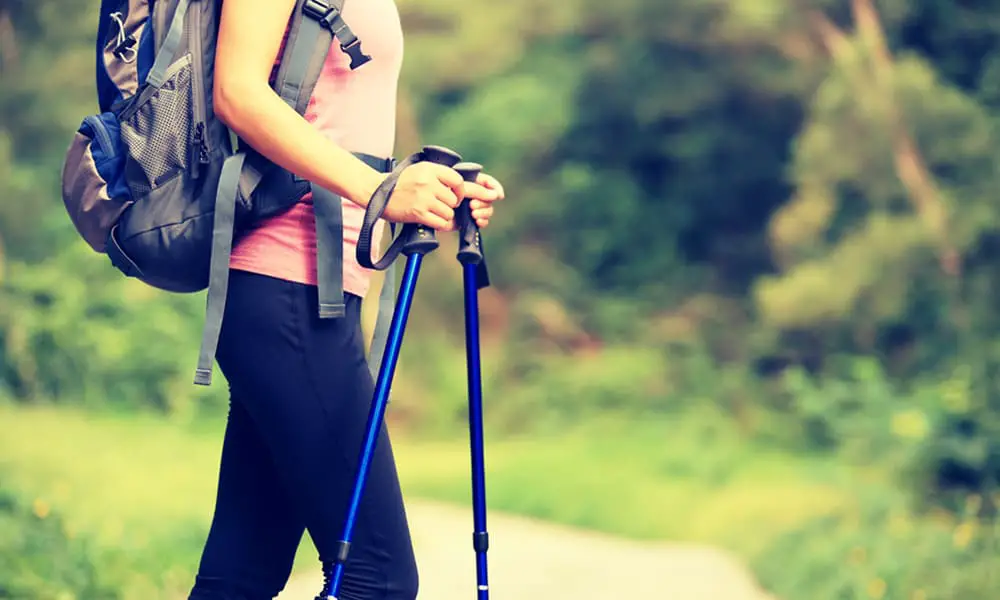
Stability: Chief among trekking poles’ benefits is stability and balance. These benefits are also their most obvious ones. Trekking poles allow you to plant yourself into the ground and use them to stabilize yourself through particularly bumpy or uneven sections of terrain. You can potentially have four points of contact with the ground instead of two. The poles allow you to use your upper body to stabilize yourself through difficult parts of your hike.
Endurance: Many benefits derive from the additional stability offered by the poles. One of the best examples of this is endurance. The poles increase your stability over difficult terrain. By doing this, they also help to share the impact of this terrain. You use the poles to help carry yourself through your hike, which significantly decreases the impact on your lower body and back. The result is that you experience less fatigue and pain, which combines to increase your endurance overall!
Speed: As your endurance increases, so too does your speed! You won’t experience as much fatigue, which means you can hustle through your hike with more conviction, leading to faster overall times. Additionally, you can get through obstacles quicker than you had before. The bottom line is a faster hike and a chance at that new personal best!
Better for Joints: The benefits of trekking poles don’t stop at performance. There are numerous health benefits, too, including one decreasing the stress on your joints for less pain and a chance of injury. The poles absorb the impact of each step, meaning that your feet aren’t absorbing the full brunt of each step. The impact spreads throughout your upper and lower body, which decreases the pressure at any given point.
The joints and muscles that become particularly sore during hikes (knees, feet, back, etc.) get some much-needed assistance, which alleviates stress at particular hot spots.
Arm Muscles: Trekking poles help to transform your hike from a lower-body workout into a full-body experience. The poles help promote an active upper body as you swing your shoulders and forearms with each step. You’ll build arm muscles as you work, and you’ll notice more engagement across your upper body.
One Trekking Pole or Two?
Now that we’ve examined the particular benefits of trekking poles, let’s look at whether you should be using one or two. A glance at your local trail, and you’ll probably find hikers who prefer either method. There are benefits to each, to the point where the best option will depend on your preference. Let’s examine each in turn:
Two Trekking Poles
Benefits of Two Trekking Poles
The main benefits of using two trekking poles are performance, support, and stability. Simply put, two work better than one.
By using two poles, you can support yourself on each step. With each step you take, plant a pole on the opposite side of your body, giving increased stability through the center. Using two poles also absorbs the impact more effectively, allowing your arms and upper body to share the load.
Two trekking poles help you reap much more of the benefits that were mentioned above. You can take more pressure off your joints, which will also increase your endurance and speed.
By decreasing the pressure on your back and knees, you’ll also find it easier to stand up straight without becoming fatigued, resulting in better posture throughout your hike, as you reduce the temptation to slouch. And we don’t have to sell you the benefits of good posture!
Trekking poles were designed to be used as a pair. Think of them like ski poles. You need to support both sides of your body because the impact is reversed when you step with each leg.
Drawbacks of Two
The main drawbacks of carrying double trekking poles are mainly related to convenience. If you’re holding two trekking poles, then you have no more free hands for anything else! Many hikers prefer having a free hand, which is why some like a single-pole (or no poles at all). It’s very much a personal preference.
Two poles also present a downside for backpackers interested in lightening their load as much as possible. Backpackers need to carry their gear through the entire trek. When each ounce matters, then it can be difficult to justify a single trekking pole, let alone two.
And finally, trekking poles can be expensive, and pairs cost more than a single pole. Trekking equipment can add up quickly. So if you aren’t convinced of the benefits of two poles, then it might not be worth the investment right away.
Our Recommendation: Trail Buddy 2-Pack
We’ll round out our section on double poles with a recommendation. If you’ve decided that two poles are right for you, then here’s a great choice! If not, then skip ahead to our section on single trekking poles.
The Trail Buddy 2-pack offers an excellent combination of performance and affordability. For trekking poles, we think you can get an excellent pair without spending too much. These poles use a lightweight aircraft-grade aluminum material. They’re quite a bit lighter than most competitors within this price range.
What we like most about these poles is their wealth of functionality. First of all, they’re fully adjustable from 25.5 inches to 54 inches. You can adjust them to meet your height and for uphill climbs and downhill descents. The handles use soft cork grip, which is comfortable and also ideal for moisture absorption. The package also includes multiple tips for various terrain (from sharp points to soft rubber tips).
Overall, they’re a quality double set at an affordable price. These are not the most lightweight poles available, but if ultralightweight is your concern, then you probably won’t be bringing two poles anyways!
Single Trekking Pole
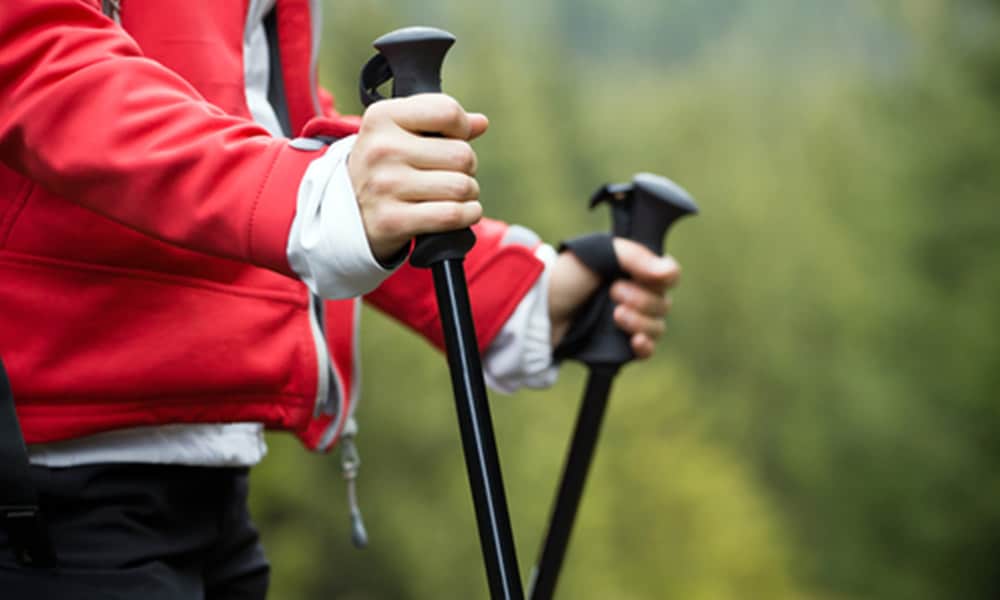
Benefits of a Single Pole
If the benefits of using two poles aren’t convincing you, a single pole may the right choice for you.
The benefits of using a single trekking pole are almost all related to convenience. By using only a single pole, you keep one hand free, which is useful for hikers who want a free hand for grabbing water, snacks, or even collecting mementos along the trail. It’s also ideal if you’re a photographer and need to be ready to snap a photo at a second’s notice.
Carrying only a single trekking pole also lightens your overall load. Many backpackers will pack only a single-pole because they can’t justify the added weight of two poles.
Drawbacks of Single Pole
The drawbacks of only using a single trekking pole are pretty self-evident. You won’t receive the full range of effectiveness by only using a single pole. You can’t stabilize yourself effectively through the center as you can with double poles, and you won’t as efficiently absorb the impact of each step.
A single-pole is still a whole lot better than nothing, and it still makes your trek easier and more efficient, but you won’t receive the full range of benefits that we mentioned above.
You have to compare this against the added convenience of only carrying a single-pole to know whether it’s the right choice for you.
Our Recommendation: KingCamp Ultralight Three Section Pole
If you’re using a single trekking pole, we assume that weight is a primary concern. In other words, you want to keep your load as light as possible, and the KingCamp pole makes a great choice.
These poles are made from 100% carbon fiber for the shaft, which is among the most lightweight materials available. They’re pricier than aluminum poles, but the difference is very noticeable if you intend on keeping your load light.
Aside from the weight, they’re very effective trekking poles. There’s an anti-slip grip, and you can adjust the pole from 26-53 inches with ease. The pole can also break into three sections to make it easier to pack into a bag. Rubber tips are included if you want less of a puncturing effect across various terrain.
Overall, it’s a great choice for a single pole. A bit on the pricier side, but well worth it in our eyes. And for a less pricey option, check out our next choice.
Alternative: Walking Stick
That’s right, perhaps the best alternative to a single trekking pole is a good old-fashioned walking stick! Pick one a hiking stick along the trail for the bargain price of free.
A walking stick lacks the functionality of a trekking pole, but many hikers still prefer it. Search for one that is long enough for your height, and you’re good to go.
The best part about a walking stick is you can use it for as long or as little as you want. Put it right back in the woods when you are done.
Using Your Poles Properly
Before we wrap up this article, we’re going to give you some advice on using your poles properly. Trekking poles are great for all the benefits mentioned above, but only if you use the poles properly. Trekking pole beginners make some common mistakes, and we want to help you avoid them. Here’s what you do:
Step 1: Get the Fit
Perhaps the most important part of using a trekking pole is ensuring that it is the proper pole length. The right pole length allows you to stand up straight while using the pole, so you can use its supportive features without any unnecessary movements.
You either want to get fitted for a pole before you buy it or buy one that you can adjust (we recommend adjustable trekking poles).
You want a pole that touches the ground when you hold it with your elbows at a 90-degree angle, tucked into your sides to ensure that they touch the ground with each step, without and unnecessary reaching on your part.
Step 2: The Motion
Once you get the proper fit, you need to master the walking motion. With a trekking pole, you want to plant the opposite pole from your forward leg. For example, if you step forward with your left foot, you bring your right pole forward to the plant. Or, if you’re using a single-pole, you can sync to whichever leg you prefer.
Proper arm motion is important to prevent unnecessary fatigue, which is why you want a smooth, compact motion. Keep your elbows tucked in to your sides throughout. Lift your forearm to bring the hiking pole forward, swinging it with your shoulders and trying to synchronize the plant with your walking motion.
Planting the pole doesn’t need to be an aggressive motion. Touch the ground with as much or as little force as you want, adjusting intensities depending on the terrain. Your trek pole should be the perfect length to graze the ground with each step. It should be a smooth, easy motion overall.
Step 3: Make The Adjustments
Once you’ve adjusted your poles and nailed your walking form, you can continue to make adjustments in response to various terrain.
As mentioned throughout this article, these poles are ideal for hiking across uneven terrain, as well as steep uphills and downhills. As you traverse, you can make adjustments to your poles which make these obstacles much more comfortable.
For downhills, it’s a good idea to lengthen your poles, if you’re using adjustable poles. Since you stick your poles in front of you as your walk, this lengthening will give them the added reach needed to account for the downhill slope.
Likewise, for uphills, you should shorten your poles. The more you use your poles, and depending on the gradient of each terrain, you’ll become more comfortable adjusting them to the perfect length required for each situation.
Making The Right Choice For You – One Pole or Two?
Ultimately, it’s your choice. Throughout this article, we’ve given you a lot of information on the benefits of one vs. two trekking poles, as well as the advantages of poles in general. But these poles are just there to help you feel comfortable, so you want to pick the option you’re comfortable with. You can experiment with both, or even start with a walking stick!
There are no wrong answers! Pick the method that works best for you and happy hiking!
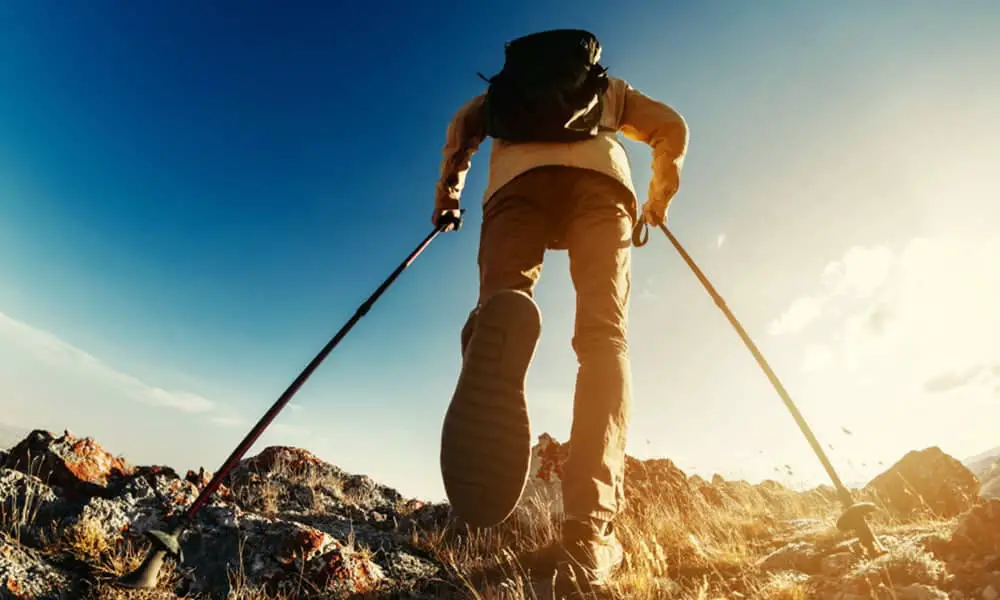
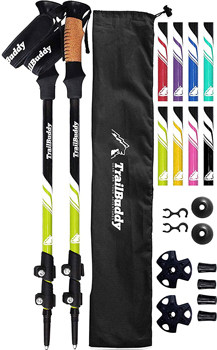
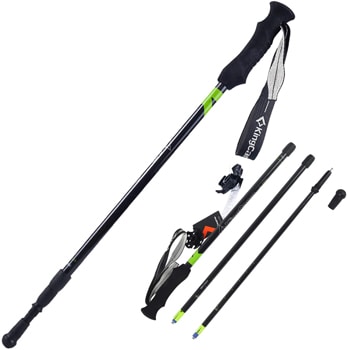






[…] Trekking pole […]